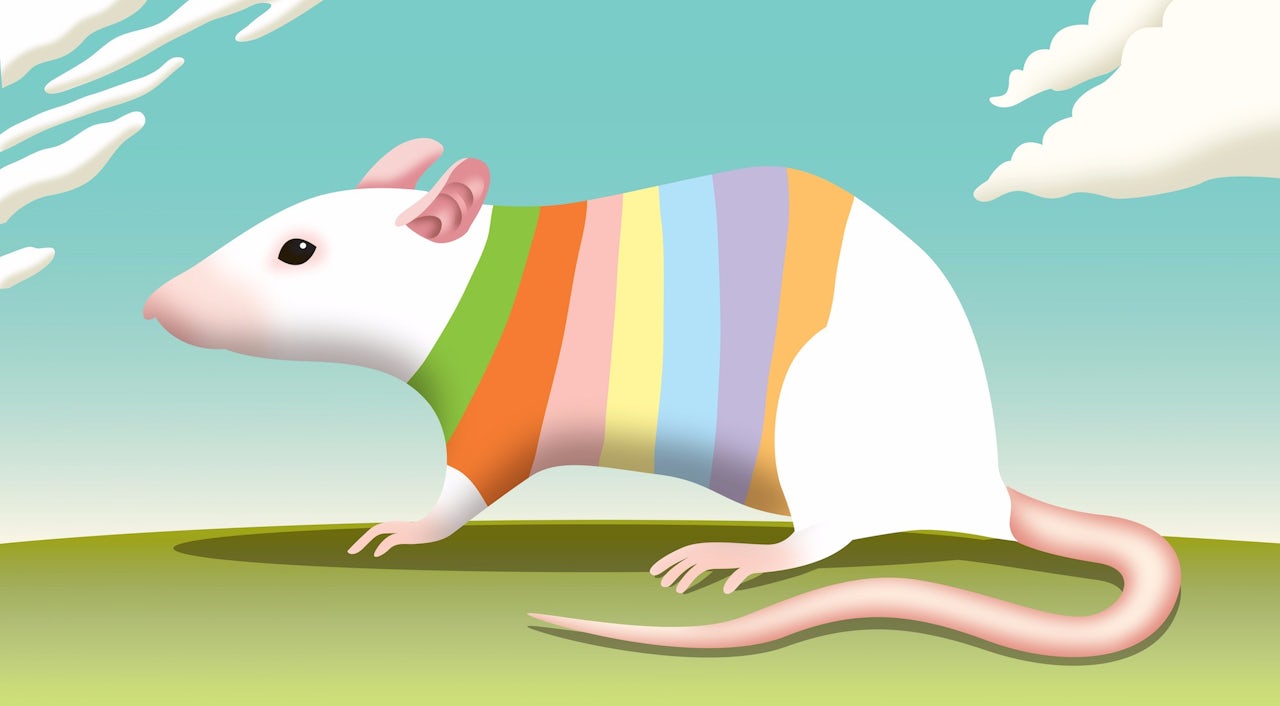In 1979, Bruce Alexander, a researcher at Simon Fraser University, separated rats into two cages, a stimulating one and an isolated one, and gave them morphine in order to measure the effect of environment on addiction rates.
The so-called “Rat Park” experiment was intended to debunk some of the flawed understanding around addiction at the time, specifically the notion that the drug itself was the most important factor in whether someone became addicted. The rats in both cages became physically dependent on the morphine, but the Rat Park rats consumed less morphine than the group in the boring cage. “Addiction isn’t you — it’s the cage you live in,” Alexander concluded.
The Rat Park study was flawed in its design and its findings, however, and it was ignored for almost three decades — until a group of experts rediscovered and started promoting it around 2008. The Rat Park study undermined one popular misconception about addiction, that chemistry of drugs is the single most important factor in addiction. But instead of pushing the popular understanding forward, it merely replaced that misconception with a new one: that environment is the most important factor.
Unfortunately, addiction isn’t that simple. The idea that there is nothing inherently dangerous about drugs — specifically opioids — is inaccurate. And with the opioid epidemic spreading throughout the country, it’s potentially dangerous.
At the time Alexander conducted his study, the United States was seven years into the War on Drugs, the trillion-dollar federal government effort to eradicate illegal street drugs by focusing on arresting and imprisoning drug sellers and users.
The prevailing rhetoric asserted that recreational drugs were inherently addictive and using them would “hijack” the brain, turning it from a “normal” brain into an addicted one. This was an oversimplified, damaging view that fundamentally misunderstood addiction and helped undermine more effective policy ideas like decriminalization and harm reduction. Alexander called this the “Myth of the Demon Drug.”
Though many had long doubted the effectiveness of increased criminalization of drugs and drug use, it took 30 years of longitudinal studies to get hard data to support that notion. In 2008, The Brookings Institute compared the “punishment” model used in the U.S. to more lenient policies in Europe, and found that it did not correlate with lower usage rates; in fact, the “combined hardcore user rate for hard drugs” was “approximately 4 times higher in the US than in Europe,” the report concluded.
As it became more apparent that the War on Drugs was a costly failure, both in terms of dollars and damage to people and communities, its critics became more vocal. And in the late aughts, they found fodder in the Rat Park experiment.
The experiment’s finding that environment is the determining factor in the development of addiction was held up as the “vital missing evidence” by the psychologist and BBC columnist Tom Stafford, and many other writers, journalists, and popular psychologists picked up the line.
In 2008, Gabor Maté, a Canadian doctor, addiction expert, and strong critic of the War on Drugs, published In the Realm of Hungry Ghosts: Close Encounters with Addiction, which was was a #1 best-seller in Canada and went on to be a New York Times bestseller as well. In the book, Maté argued that the War on Drugs has been a failure and argues for more comprehensive, compassionate treatment of people struggling with addiction. He devoted a chapter to establishing how environment can be a significant contributing factor in developing an addiction. He cited the Rat Park experiment as well as a study published in 1975 which showed that rates of heroin addiction were 20 times higher for Vietnam soldiers while they were stationed in the war zone than before they shipped out. After they returned to the U.S., addiction rates fell back to pre-deployment levels.
After the signal boost from In the Realm of Hungry Ghosts, folks interested in understanding addiction wrote excitedly about the study. The psychologist and author Lauren Slater devoted a chapter to Rat Park in her 2004 book, Opening Skinner’s Box: Great Psychological Experiments of the 20th Century. Stuart McMillen produced a science comic book about Rat Park and put it on the internet. The controversial former UK chairman of the Advisory Council on the Misuse of Drugs David Nutt, who was asked to step down after saying he thought alcohol and tobacco were more harmful than cannabis, LSD, and ecstasy, referred to the study in his 2012 book Drugs Without the Hot Air. Cory Doctorow, founder and editor of the popular website BoingBoing, read Nutt’s book and wrote an article praising the Rat Park study.
The Rat Park experiment provides seemingly perfect evidence to explain why the War on Drugs is such a failure, because its policies focus on drugs as the source of the problem. While the failure of the War on Drugs is virtually undisputed among experts in the field of addiction — though sadly not represented by significant changes in policy, as drug offenses are the “single biggest factor” contributing to booming incarceration numbers — Alexander’s emphasis on the user’s environment was novel and presented obvious implications for drug policy.
The buzz Dr. Maté had generated around the Rat Park experiment became a roar in 2015, when Johann Hari published Chasing the Scream: The First and Last Days of the War on Drugs. Focusing heavily on the work of Maté and Alexander, Hari asserts that he has discovered the “likely cause” of addiction: a lack of human connection. Just as the rats in the isolated rat park cage needed social interaction and connection with other rats, Hari wrote, so do humans. Alexander believed a poor environment causes addiction; Hari asserted that the disconnection that arises from a poor environment creates addiction.
Despite a poor review in the New York Times, Chasing the Scream went on to be on the best-seller lists for weeks. Hari’s TED talk, modestly titled “Everything You Know About Addiction Is Wrong,” has been viewed over three million times.
In 2017, the Rat Park study continues to be cited as a “classic experiment” in the field of addiction.
“All those who subscribe to [a] sociological theory of addiction trot [the Rat Park experiment] out as if it establishes their premise,” said Dr. Sam Snodgrass, a member on the Board of Directors of the substance abuse support organization Broken No More. “The problem is that most people aren't scientists and believe whatever they read.”
Unfortunately, the Rat Park study had some issues.
Despite his claims of a revolutionary breakthrough, Alexander had trouble finding a journal to publish his results. Both Science and Nature rejected the study for publication, likely due to significant problems with the methodology and results. Pharmacology Biochemistry and Behavior published the results in 1981 with little response and the funding for Rat Park was canceled shortly thereafter.
The Rat Park experiment provides seemingly perfect evidence to explain why the War on Drugs is such a failure
Alexander lost eight days’ worth of data due to a malfunctioning piece of electronic equipment used to measure the amount of liquid the rats consumed, which may or may not have impacted his results. He also failed to control for important variables, Snodgrass said. For example, male and female rats in the boring cage were isolated from each other, he said, but they were housed together in the Rat Park cage. Soon, Rat Park was filled with rat pups. Alexander never explained what happened to the pups, Snodgrass said, such as whether they were removed or left in the cage and somehow factored into the results. “The females would wean one litter after approximately 18 days and then would begin to cycle again,” Snodgrass said. “You can’t do this. You can’t have one group of subjects mating and with pups and compare it to a group that doesn’t engage in these behaviors and say that the difference between the two groups is caused by environmental differences.”
When scientists tried to replicate the Rat Park study, they got mixed results. In 1996, a study attempted to precisely replicate the conditions in Alexander’s Rat Park, down to the breed of rat. The researchers conducted two experiments to see if they could replicate the Rat Park study’s results. In the first experiment, the happy, social rats consumed slightly more of the morphine liquid, in the second experiment, the isolated rats drank slightly more. Neither experiment reflected the Rat Park’s results, which had the isolated rats drinking up to seven times the amount of the morphine liquid as the social rats. The authors of the study note that in 1979 the supplier both they and Alexander used for Wistar rats changed, noting that “the Wistar rats used in the Alexander, et al. study were Old Colony Wistar rats, and the ones used in the 1996 were New Colony Wistar rats.” The author concluded that the difference in behavior between the rats in the initial Rat Park study and the 1996 study were, “likely genetic in nature” (Petrie, 1996). This is especially notable considering Alexander’s current position that genetics do not play any role in the development of addiction.
Other studies did indeed replicate the results of Alexander’s Rat Park, as he notes on his website.
Finally, there is the obvious fact that rats aren’t human and thus behave differently than humans do. Dr. Adi Jaffe notes how this specifically impacts the Rat Park study here.
So if the four-decades-old Rat Park experiment provided important but partial, or inconclusive, evidence about the cause of addiction, why is it still being touted as the “missing link” to understanding addiction today? In part, the persistence and ineffectiveness of the War on Drugs is to blame.
Alexander’s study was an important breakthrough in understanding addiction, but the results were far from conclusive. The study’s real problems have less to do with the science and more to do with the grandiose claims made based on the results. For example, morphine (an opioid) was the only type of drug used in the experiment, but Alexander extrapolated that addiction to all drugs would present similarly. This is likely because his theory states that the drug itself is almost irrelevant — addiction is determined by environment, not the drug itself. He writes that “addiction to drugs as well as other habits and pursuits” happens when people “feel ‘caged.’”
There is likely some truth to this. Certain people are more vulnerable to addiction than others; many people can use any array of drug without becoming addicted. But although addiction experts disagree slightly about where certain drugs should be on a spectrum of most to least addictive, almost all agree that there is indeed a spectrum. It would be willfully ignorant to say that a person is equally likely to become addicted to cannabis as they are to oxycontin or fentanyl. Of course the drug in question matters. So do a plethora of other factors. In reality, there are many factors that lead to addiction, including environment, stress, genetics, life-circumstances, and adverse childhood experiences (ACEs). It is not uncommon for people with addictions to have any combination of the above factors, nor is it an exhaustive list. These factors also have different effects on different individuals. For example, people who suffer from a mental illness are twice as likely to struggle with addiction. But both Hari and Alexander still claim they’ve discovered the “real,” implying singular, cause of addiction.
The point that Rat Park is used to underscore is true. Environment often plays a role in a person developing an addiction and the War on Drugs does nothing to address that. In fact, the War on Drugs has done tremendous harm by ignoring the sociological factors that contribute to addiction and focusing exclusively on criminalization. Alexander and Hari argue that we need a more humane approach to drug policy, a belief that is widely shared. But ignoring the greater body of addiction science in favor of a neat narrative is the kind of thinking that fueled the War on Drugs. It’s precisely because this is such an important fight that we should make sure our arguments, and the evidence we use to support them, are sound.




